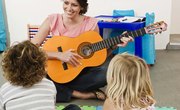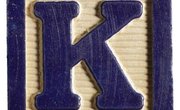Phonemic awareness is the ability to identify and hear the individual sounds that letters make. Being able to identify these sounds is one of the first stages of literacy development and is essential for success in reading and writing. During first grade, phonemic awareness is a large focus of literacy instruction. Adults can use several activities to promote phonemic awareness in young learners.
Beginning Letter Sounds
This lesson requires students to use listening skills to identify the letter used at the beginning of a given set of words. Provide students with small dry-erase boards and dry-erase pens. Inform them that you're going to state a variety of words and upon doing so, they must listen closely to try to identify the letter that makes the first sound in each of the words. Once they think they've determined the letter that makes the sound at the beginning of each word, they should write it down on their dry-erase boards and hold it up. For example, if you say the word "cat," students should write the word "C" on their boards. Review what's written on each board and clarify if students seem confused about a particular sound.
Find the Sound
In this lesson, students must identify where a given sound is in a list of words. On index cards, write "B" for beginning, "M" for middle and "E" for end for each student in your class and distribute the cards. Explain to students that you're going to tell them a sound and after stating the sound, you're going to state a series of words, and after hearing each word, students are to hold up the card that illustrates if the sound was heard at the beginning, in the middle or at the end of the word. For example, if you are working on the digraph "sh" and say the word "fish," students should hold up the "E" card. Offer help if needed.
Rhyming Word Match
Rhyming helps students relate words that share common sounds. Create rhyming worksheets for your students. On the top of the worksheets, include a picture of an item -- a bat, for instance -- that serves as the reference word for the lesson. On the rest of the page, include pictures of items that rhyme and don't rhyme with the word "bat." Distribute the worksheets to students, review the key sound "at" in the word "bat," and instruct them to circle the pictures on the work sheet that rhyme with or have the same key sound. Review the answers as a whole class.
How Many Sounds?
Students work on identifying how many sounds they hear in words with this lesson. Discuss how words are made up of two or more sounds. Say a few words and discuss how many sounds are in each word. For example, you could say the word "jug" and then slowly say the word, enunciating each of the sounds; j/u/g. Say a word and ask for a volunteer to tell the class how many sounds are in the word.
Related Articles
References
Writer Bio
Lily Mae began freelance writing in 2008. She is a certified elementary and literacy educator who has been working in education since 2003. Mae is also an avid gardener, decorator and craft maker. She holds a Bachelor of Arts in education and a Master of Science in literacy education from Long Island University.










